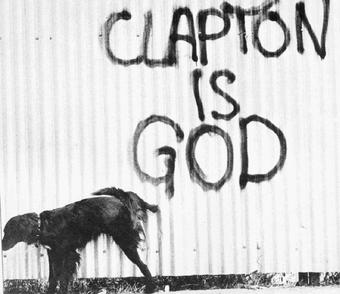This month, we welcome God himself into the humble pages of this blog. That is, God in the shape of Eric Clapton in his early career – specifically the legendary “Beano” album recorded with John Mayall's Bluesbreakers.
And you're going to have to forgive me for feelig just the tiniest bit smug, as I set myself the goal of transcribing all the solos off this one through September – and managed it! So that's this and “Live At The Regal” done – 2020 is proving to suck for pretty much everyone, but I will definitely be finishing this year a far better player than I started it as. I would absolutely recommend setting aside a portion of your practice time to work on transcription, almost regardless of ability level, as improving your ear is so crucial to developing every aspect of musicianship.
Anyway, enough digression – let's look at EC himself. As he's so deeply ingrained into the mainstream musical “establishment” now, it's hard to picture Clapton as a rock & roll outsider, but in the early 1960's that is exactly what he was. He began his guitar journey with something that we can all identify with - being given a cheap guitar by a kindly but uninformed relative, discovering that cheap = badly made & VERY difficult to play (at least it did before Yamaha brought out the Pacifica 112 in the 90s), and putting it down feeling like it's an impossibility. This false start – very similar to what I had myself at that age – would be remedied a couple of years later and Clapton began playing in earnest age 15, now motivated by a deep seated love of the blues music coming out of America. He would practice long hours, poring over licks and solos to get each one just so, often recording himself on a reel to reel tape recorder to check his progress.
In 1961 the now 16 year old Clapton enrolled in Kingston Art College but his focus remained on music and he took to busking around the area, starting to play more with other musicians and local bands before finding his first high profile gig with The Yardbirds in October of 1963. They were primarily focused on blues and rock & roll, but in March of 1965 had a breakthrough pop single with “For Your Love” which took them in a completely different directoion, and not one Clapton was happy with. He left, and joined John Mayall's Bluesbreakers in April of 1965 recording the famous “Beano” album with them. This is a semi-legendary album in guitar circles because at the time it really wasn't like anything that had been done before. Distortion, for example, was not something considered desirable by amp manufacturers so Clapton would push his Les Paul and Marshall to absolutely ear splitting volumes in order to get the thick, sustaining sound heard on tracks like “Steppin' Out” and his famous cover of “Hideaway”. His pentatonic pyrotechnics were also a world away from the sounds of someone like Hank Marvin or the Beatles which were most people's reference points for what a guitar should sound like, and what guitar playing was at that point.
Clapton would leave the band briefly in 1965 before rejoining, and then leaving again (admitting himself in later years to have been more than a little “flaky”) in July of 1966, ironically enough before the album itself had been released. He would go on to form Cream, another blues rock powerhouse and important link in the chain, but that's a story for another time – we're looking at EC's Bluesbreaker plaing this month.
I've lost count of the number of times I've written this now, but the basis of his style is the combination of minor and major pentatonics – as it has been with everyone we're looking at, we're looking much more at the “how” than the “what”. Let's start with the iconic opener to the album – the cover of the Otis Rush song “All Your Love”.
This opening “rip” up the fretboard was in itself a pretty bold statement, as it's immediately distinctive and not something most listeners would have heard before, especially performed with such volume and ferocity.
Clapton was also fond of repicking bent notes, something seen in his “Little Girl” solo where his rhythms double up what the basis is playing, crafting the solo into the fabric of the song rather than being a “here's twelve bars for you, go nuts” approach.
And I couldn't finish this without showing a couple of examples of his masterful blending of major and minor pentatonics:
We'll return to EC next year looking at his Cream – era playing, as he's such an influential player, but next month we're back across the Atlantic to check out Mike Bloomfield – till then, stay safe, stay sane, play they blues HARD!






